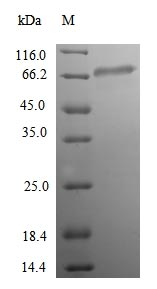Amino acids 38-689 constitute the expression domain of recombinant Human ACSS1. This ACSS1 protein is theoretically predicted to have a molecular weight of 75.1 kDa. This ACSS1 protein is produced using e.coli expression system. The N-terminal 6xHis tag was fused into the coding gene segment of ACSS1, making it easier to detect and purify the ACSS1 recombinant protein in the later stages of expression and purification.
The human Acetyl-coenzyme A synthetase 2-like, mitochondrial (ACSS1) is a key enzyme involved in cellular energy metabolism. It catalyzes the conversion of acetate to acetyl-coenzyme A (acetyl-CoA), a critical intermediate in various metabolic pathways. ACSS1 plays a pivotal role in utilizing acetate as an alternative carbon source during metabolic stress or fasting. Research on ACSS1 spans areas of cellular energy homeostasis, metabolic adaptation, and understanding its implications in diseases related to altered metabolism. Exploring ACSS1 functions enhances the knowledge of fundamental metabolic processes, offering potential insights into therapeutic strategies for conditions where metabolic pathways are dysregulated, such as metabolic disorders or certain cancers.






